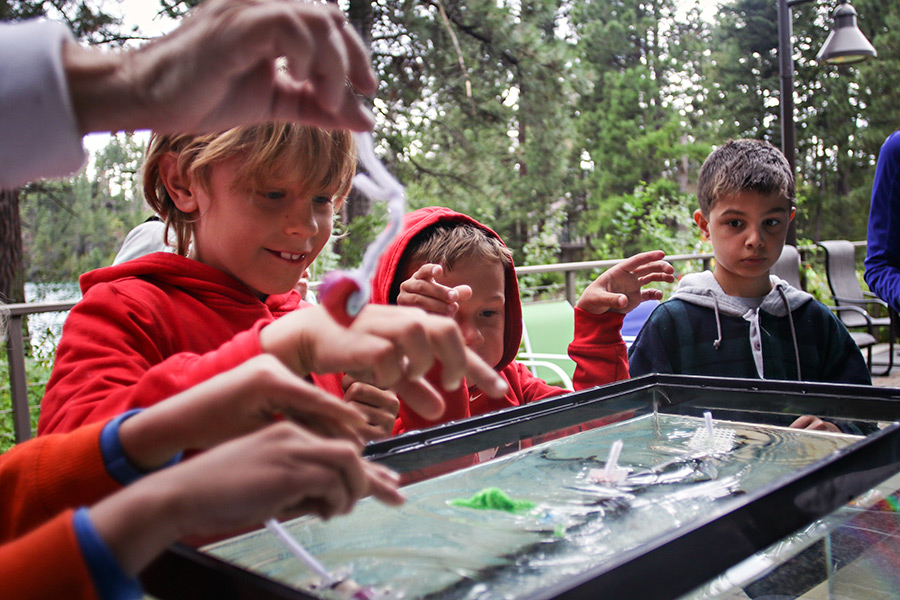Elser Era Dawns at Flathead Lake Biological Station
New director aspires to create 'best freshwater biological station in the world,’ building sensor development facility
By Dillon Tabish
YELLOW BAY — Jim Elser is not simply sitting back and enjoying the lake views from his new office. The new director of the University of Montana’s storied Flathead Lake Biological Station is hitting the ground running with grand ambitions.
“Somehow as good as the bio station is, it’s going to get even better. Our goal at the end of this process is to be the best freshwater biological station in the world,” Elser told a crowd gathered for an open house on Aug. 3.
“That’s our aspiration.”
Elser, who replaced Jack Stanford in March and became the station’s seventh director in its 117-year history, said he is honored to join a facility with such a strong reputation and legacy. Elser plans to build on the station’s identity as an advanced research facility while continuing its monitoring mission as “the sentinel of the lake.” The station will also grow its educational opportunities beyond the collegiate level; his wife, Monica, is engaging with local school districts to increase youth learning programs through Yellow Bay.
The importance of preserving Flathead Lake and the region’s freshwater resources is paramount for several reasons, including economical, he said.
According to research conducted in 2014 by the University of Montana, Flathead Lake’s pristine identity had an estimated $6-8 billion impact on shoreline property values and is worth roughly $1.6 billion in “nature-based tourism” in Flathead and Lake counties.
“This is important stuff,” Elser said. “All those aesthetics and emotions turn into real value when you talk about an economy that’s driven by nature-based tourism.”
Beyond the ecological motivation, there is a significant economical reason to fight against aquatic invasive species, which are a persistent threat to lakes across the country. As an example, Elser pointed to Wisconsin’s Lake Mendota, which has been overrun by spiny water fleas that led to heightened algae levels as a result. A once-clear lake is now green and murky due to the invasion.
“Clear water is worth money,” Elser said.
Montana spends roughly $1 million annually to defend against aquatic invasive species, with awareness campaigns and detection stations during the summer. In comparison, Idaho spends roughly $10 million in the battle against AIS.
“This is the lake that our descendants will inherent from us,” Elser said, pointing to Flathead Lake, “and it’s intuitive on us to keep it in good condition for the future.”
The opportunity to study a pristine environment such as the Flathead watershed is what drew Elser here originally, and it’s living up to his expectations. The day before delivering his open-house presentation, Elser hiked over 17 miles in Glacier National Park to a newborn lake at the foot of Sperry Glacier. He and a group of researchers gathered samples from the newly formed waters at the base of the retreating glacier.
“These are brand new lakes and no one really knows anything about them,” he said. “It’s an unfortunate experiment with climate change. We’re asking cutting-edge questions.”
Elser has also recruited a pair of world-class researchers who will move to Flathead Lake for new research. Matt Church, a respected oceanographer, will be joining the team of researchers from Hawaii.
Cody Youngbull, a physicist and entrepreneur with a Ph.D. in condensed matter physics, is joining the bio station to develop a new facility on the campus that will build state-of-the-art sensors and robotics used in water environments. These sensors will be able to detect past and present signs of life in the depth of the lake, or study DNA in the water, among other possibilities. The new facility, which will be built over the next year, will include manufacturing and robotic equipment, including 3D printers, as well as laser cutting systems. The facility will be open to all types of researchers and entrepreneurs who hope to create innovative sensor technology, Youngbull said.
“(Jim) wants to turn this into the smartest lake in the country. And I can see a lot of reasons why my colleagues want to come out here and test their equipment and build sensors and get access to this very special lake and the high-altitude lakes all around here, too,” Youngbull said. “It’s a great test bed.”